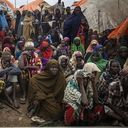Famine at Somalia's door

The United Nations put out a dire warning earlier this week: famine is "at the door in Somalia."
Driving the news: Famine is expected in parts of southern Somalia between October and December unless urgent assistance gets to those most in need, the UN said. Humanitarian groups are urging the international community to act now, saying waiting for a formal famine declaration will be too late.
As Somalia prepares to cope with its second famine in just over a decade, here's a look at what famine is and why formal declarations are rare:
What is famine and when is it declared?
Since 2004, famine has been scientifically defined under the Integrated Food Security Phase Classification (IPC) system.
- Famine at phase 5 is the highest on the scale and is defined "as an extreme deprivation of food."
A famine is classified under the IPC system when:
- At least 20% of an area's households are facing an extreme lack of food;
- 30% of children are suffering from acute malnutrition; and
- Two people out of every 10,000 are dying every day due to starvation or the combination of malnutrition and disease.
Once the IPC country working group classifies a famine, it's up to relevant stakeholders (usually the UN in coordination with a country's government) to make a formal declaration.
- Such classifications and declarations are often rare due to challenges in obtaining the needed data to assess food insecurity in a region or country because of inefficient data-gathering resources, conflict, and lack of access to affected areas, among other reasons.
Where have previous famines been declared?
Somalia
- 2011: The last famine in Somalia was officially declared in July 2011, though the UN estimates it began in October 2010 and ended in April 2012. More than a quarter of a million people died — half of them were children.
South Sudan
- 2017: Parts of South Sudan experienced famine from February-June 2017, with millions affected. The death toll from this famine remains unclear.
The big picture: Households experiencing catastrophic levels of acute food insecurity may be classified as a IPC Phase 5 catastrophe even if the area does not meet the criteria for a famine.
- This was the case for hundreds of thousands of people in parts of Ethiopia's Tigrey region last year and for tens of thousands in Afghanistan's Ghor province this year.
- The IPC in recent years also adopted a "famine likely" classification, which is often used when data about food insecurity is scarce, but the available data indicates a famine is occurring or likely occurring.
Between the lines: A number of famines occurred prior to the start of the IPC system, including the 1992 Somalia famine that killed an estimated 220,000 people.
What is happening in Somalia now?
More than 7.1 million people — nearly half of Somalia's population — are currently in need of food assistance, according to the UN.
- More than 1 million people have been displaced by drought since it began in January 2021, per the UN refugee agency.
- Famine is expected later this year in the Bay Region's Baidoa and Burkhaba districts, as well as in displaced populations in Baidoa settlements of southern Somalia unless aid is significantly scaled up, the latest IPC report warned.
Children in Somalia are especially vulnerable.
- At least 1.5 million children across the country are expected to face acute malnutrition by October, according to the UN.
- "None of the children that I saw at the stabilization center in Banadir hospital could smile. Very few could cry," UN aid chief Martin Griffiths told reporters earlier this week during his trip to Somalia.
- "As we discovered when we left, we had the good fortune to hear a child cry, and we were told that when a child cries, there is a chance of survival. Children who don’t cry are the ones we need to worry about," he added.
The latest IPC analysis serves as a "final warning," Griffiths said.
- "The situation and trends resemble those seen in 2010-2011, in that crisis. Except now they are worse," he added.
- Half of the deaths from the last famine in Somalia happened before a formal declaration was made in 2011, aid groups note in urging the international community to act now.
Why is Somalia facing famine this year?
The current humanitarian crises in Somalia — and the larger Horn of Africa region — are due to a number of factors, including:
Protracted drought: The Horn of Africa is experiencing its worst drought in four decades, with four consecutive failed rainy seasons and the fifth projected to fail as well.
- Climate change worsens droughts in part by making them hotter, thereby drying out the landscape further.
Prolonged conflict: Three decades of political stability and civil war, including the ongoing insurgency led by the al-Shabaab armed group have only worsened Somalia's humanitarian crises.
- Ongoing conflict makes it harder to collect data on and get aid to those most in need, particularly in a country still reeling from the coronavirus pandemic.
Soaring food prices: Russia's invasion of Ukraine sent global food prices to record highs.
- Somalia sourced 90% of its wheat from the two countries prior to this year.
- Ukraine said this week that grain is headed to Somalia. But the skyrocketing food prices have already had detrimental consequences in the East African nation, including on people's ability to buy food and humanitarian groups' operations.
Funding shortfalls: With the world's attention largely focused on the war in Ukraine, protracted humanitarian crises have seen worsening funding shortfalls, aid groups say.
The bottom line
- The international community is "in the last minute of the eleventh hour to save lives" in Somalia, the UN's Griffiths warned this week.
- "The clock is running, and it will soon run out."